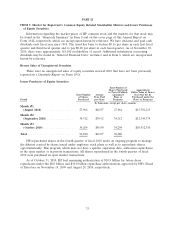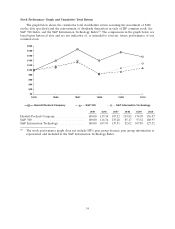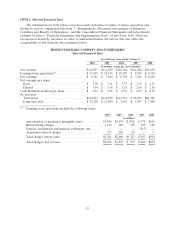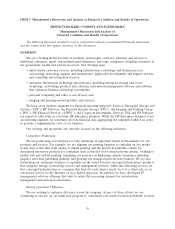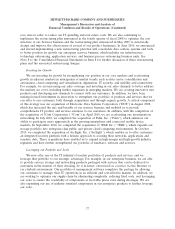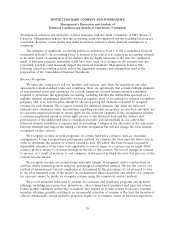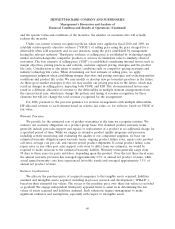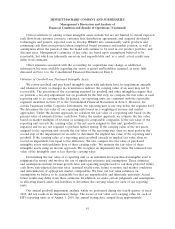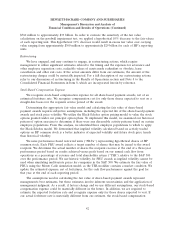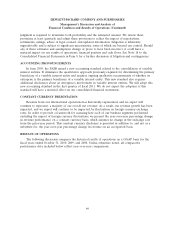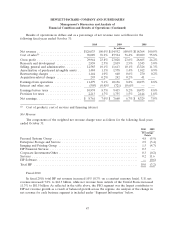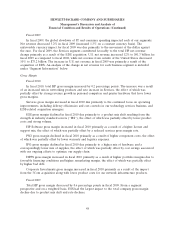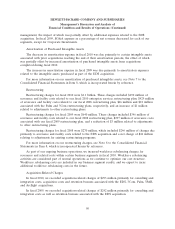HP 2010 Annual Report Download - page 49
Download and view the complete annual report
Please find page 49 of the 2010 HP annual report below. You can navigate through the pages in the report by either clicking on the pages listed below, or by using the keyword search tool below to find specific information within the annual report.HEWLETT-PACKARD COMPANY AND SUBSIDIARIES
Management’s Discussion and Analysis of
Financial Condition and Results of Operations (Continued)
Critical estimates in valuing certain intangible assets include but are not limited to: future expected
cash flows from customer contracts, customer lists, distribution agreements, and acquired developed
technologies and patents; expected costs to develop IPR&D into commercially viable products and
estimating cash flows from projects when completed; brand awareness and market position, as well as
assumptions about the period of time the brand will continue to be used in our product portfolio; and
discount rates. Management’s estimates of fair value are based upon assumptions believed to be
reasonable, but which are inherently uncertain and unpredictable and, as a result, actual results may
differ from estimates.
Other estimates associated with the accounting for acquisitions may change as additional
information becomes available regarding the assets acquired and liabilities assumed, as more fully
discussed in Note 6 to the Consolidated Financial Statements in Item 8.
Valuation of Goodwill and Purchased Intangible Assets
We review goodwill and purchased intangible assets with indefinite lives for impairment annually
and whenever events or changes in circumstances indicate the carrying value of an asset may not be
recoverable. The provisions of the accounting standard for goodwill and other intangibles require that
we perform a two-step impairment test on goodwill. In the first step, we compare the fair value of each
reporting unit to its carrying value. In general, our reporting units are consistent with the reportable
segments identified in Note 19 to the Consolidated Financial Statements in Item 8. However, for
certain businesses within Corporate Investments, the reporting unit is one step below the segment level.
We determine the fair value of our reporting units based on a weighting of income and market
approaches. Under the income approach, we calculate the fair value of a reporting unit based on the
present value of estimated future cash flows. Under the market approach, we estimate the fair value
based on market multiples of revenue or earnings for comparable companies. If the fair value of the
reporting unit exceeds the carrying value of the net assets assigned to that unit, goodwill is not
impaired and we are not required to perform further testing. If the carrying value of the net assets
assigned to the reporting unit exceeds the fair value of the reporting unit, then we must perform the
second step of the impairment test in order to determine the implied fair value of the reporting unit’s
goodwill. If the carrying value of a reporting unit’s goodwill exceeds its implied fair value, then we
record an impairment loss equal to the difference. We also compare the fair value of purchased
intangible assets with indefinite lives to their carrying value. We estimate the fair value of these
intangible assets using an income approach. We recognize an impairment loss when the estimated fair
value of the intangible asset is less than the carrying value.
Determining the fair value of a reporting unit or an indefinite-lived purchased intangible asset is
judgmental in nature and involves the use of significant estimates and assumptions. These estimates
and assumptions include revenue growth rates and operating margins used to calculate projected future
cash flows, risk-adjusted discount rates, assumed royalty rates, future economic and market conditions
and determination of appropriate market comparables. We base our fair value estimates on
assumptions we believe to be reasonable but that are unpredictable and inherently uncertain. Actual
future results may differ from those estimates. In addition, we make certain judgments and assumptions
in allocating shared assets and liabilities to determine the carrying values for each of our reporting
units.
Our annual goodwill impairment analysis, which we performed during the fourth quarter of fiscal
2010, did not result in an impairment charge. The excess of fair value over carrying value for each of
HP’s reporting units as of August 1, 2010, the annual testing date, ranged from approximately
41




